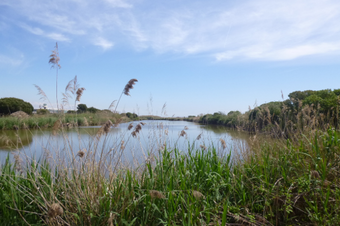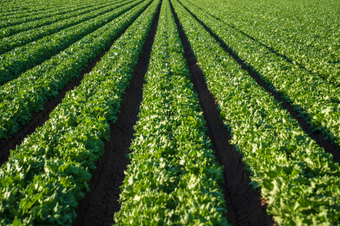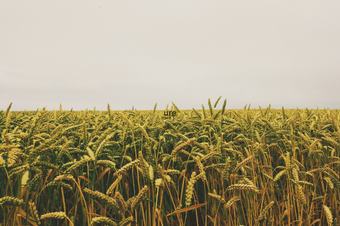
Land-Sparing and Sharing: Identifying Areas of Consensus, Remaining Debate
and Alternatives
” The land-sparing sharing debate examines two scenarios for reconciling agricultural production and biodiversity conservation while maintaining the same level of production: high yielding agriculture with large habitat blocks (sparing), and low-yielding “wildlife friendly” agriculture with small habitat fragments (sharing). While originally conceived as an ecological model, much ensuing debate focused on political, social and economic realities. We identify areas of consensus and continuing debate, and present alternatives that combine aspects of sharing and sparing. Specifically, we summarize evidence that large habitat blocks, surrounded by diversified farming systems, will best support biodiversity and sustainable food production.”
Read more in the article by IBioS faculty member Dr. Claire Kremen and colleague Ilke Geladi.

Exploring the emergence of a tipping point for conservation with increased recognition of social considerations
“Despite a common understanding of the harmful impacts of Western conservation models that separate people from nature, widespread progress towards incorporating socio-economic, political, cultural, and/or spiritual considerations in conservation practice continues to lag behind. For some, the concept of “nature-based solutions” (NbS) is seen as an interdisciplinary and holistic pathway to better integrate human wellbeing in conservation. Using the Wildlife Conservation Society’s Climate Adaptation Fund as a case study, we examine how conservation practitioners within the United States view NbS and how social considerations are (or are not) incorporated into conservation adaptation projects”
Read more in the article by IBioS faculty member Dr. Shannon Hagerman and colleagues.

Plant community compositional stability over 40 years in a Fraser River Estuary tidal freshwater marsh
“Long-term data sets documenting temporal changes in vegetation communities are uncommon, yet imperative for understanding trends and triggering potential conservation management interventions. For example, decreasing species diversity and increasing non-native species abundance may be indicative of decreasing community stability. We explore long-term plant community change over a 40-year period through the contribution of data collected in 2019 to two historical datasets collected in 1979 and 1999 to evaluate decadal changes in plant community biodiversity in a tidal freshwater marsh in the Fraser River Estuary in British Columbia, Canada. We examine whether characteristic plant assemblages are consistent over time, whether alpha (α) and beta (β) diversity change within and between assemblages, and whether associated indicator species change. We found that plant assemblages were characterized by the same dominant indicator species, but most other indicator species changed, and that overall αdiversity decreased while β-diversity increased.”
Read more in the article by IBioS faculty member Dr. Tara Martin and colleagues.

Crop diversity buffers the impact of droughts and high temperatures on food production
“Weather extremes like droughts and heat waves are becoming increasingly frequent worldwide, with severe consequences for agricultural production and food security. Although the effects of such events on the production of major crops is well-documented, the response of a larger pool of crops is unknown and the potential of crop diversity to buffer agricultural outputs against weather extremes remains untested. Here, we evaluate whether increasing the diversity of crop portfolios at the country level confers greater resistance to a country’s overall yield and revenues against losses to droughts and high temperatures. To do this, we use 58 years of annual data on weather, crop yields and agricultural revenues for 109 crops in 127 countries. We use the spatial distribution of each crop and their cropping cycle to determine their exposure to weather events.”
Read more in the article by IBioS faculty member Dr. Frederik Noack and colleagues.

The rights way forward: reconciling the right to food with biodiversity conservation
“The current paradigm of biodiversity conservation, with its continued focus on the notion of pristine nature, has resulted in the separation of humans and nature at the expense of both biological and cultural–linguistic diversity. The continued annexation of land for the cause of conservation has resulted in the curtailment of both rights and access to local and diverse food sources for many rural communities. Indigenous Peoples and local communities are fundamental to conserving biodiversity through sustainable use of nature despite repeated attempts to dispossess them from their lands, cultures and knowledge. It has been this
traditional and land-based knowledge that has contributed to the conservation of biodiversity whilst also supporting healthy, diverse and nutritious diets.”
Read more in the article by IBioS faculty member Dr. Terry Sunderland and colleagues.

Two-Eyed Seeing: Developing perspective and wisdom on sea lamprey in the Laurentian Great Lakes
“Bridging knowledge systems is a potential means of equitably and collaboratively working towards improved conservation and management of aquatic ecosystems, such as the management of invasive species. Etuaptmumk (Two-Eyed Seeing) is a Mi’kmaw framework that encourages the bridging of Indigenous and Western knowledge systems to work together in parallel on a shared issue or problem. Invasive species pose a significant threat to aquatic ecosystems, and they are disrupting fisheries and entire lake ecosystems within the Laurentian Great Lakes. Sea lamprey (Petromyzon marinus) are one example of an invasive species in these Great Lakes with an established control program. Sea lamprey management faces many challenges including possible declining social acceptance of control programs, especially amongst Indigenous communities in the region.”
Read more in the article by IBioS faculty member Dr. Andrea Reid and colleagues.

Championing inclusive terminology in ecology and evolution
“Amid a growing disciplinary commitment to inclusion in ecology and evolutionary biology (EEB), it is critical to consider how the use of scientific language can harm members of our research community. Here, we outline a path for identifying and revising harmful terminology to foster inclusion in EEB.”
Read more in the article by IBioS faculty members Dr. Alex Moore, Dr. Kaitlyn Gaynor and colleagues.

The fitness value of ecological information in a variable world.
“Information processing is increasingly recognized as a fundamental component of life in variable environments, including the evolved use of environmental cues, biomolecular networks, and social learning. Despite this, ecology lacks a quantitative framework for understanding how population, community, and ecosystem dynamics depend on information processing. Here, we review the rationale and evidence for ‘fitness value of information’ (FVOI), and synthesize theoretical work in ecology, information theory, and probability behind this general mathematical framework. The FVOI quantifies how species’ per capita population growth rates can depend on the use of information in their environment. FVOI is a breakthrough approach to linking information processing and ecological and evolutionary outcomes in a changing environment, addressing longstanding questions about how information mediates the effects of environmental change and species interactions.”
Read more in the article by IBioS faculty member Dr. Mary O’Connor and colleagues.

The application of assisted migration as a climate change adaptation tactic: An evidence map and synthesis
“Assisted migration entails the human assisted movement of individuals to more climatically-suitable areas within or outside of their current species range to help species respond to climate change. To better understand the potential for assisted migration to benefit species threatened by climate change, we conducted an evidence synthesis to map examples where assisted migration has been implemented around the world. With this mapping exercise, we collate and describe the quantity and key characteristics of the available evidence base, including the taxa, species conservation status, locations, and contexts relating to the use of this conservation tactic. Findings from this exercise highlight that assisted migration has been implemented very few times as a conservation tactic, though assisted migration has been conducted experimentally (for research purposes) and inadvertently (e.g., for reforestation) much more frequently.”
Read more in the article by IBioS faculty member Dr. Sally Aitken and colleagues.

The RACE for freshwater biodiversity: Essential actions
to create the social context for meaningful conservation
“Freshwater habitats are experiencing two to three times the rate of biodiversity
loss of terrestrial and marine habitats. As status quo actions within the conservation community are not reversing the downward trajectory for freshwater biodiversity, we propose four actions to shift the narrative such that freshwater biodiversity is no longer invisible and overlooked, but rather explicitly recognized, valued, and protected: (1) Reshape our relationship with freshwater habitats and biodiversity, (2) Appreciate indigenous knowledge systems relating to
freshwater habitats, (3) Connect science more directly to action, and (4) Elevate freshwater habitats as a unique “domain” that requires explicit recognition in conservation planning (RACE). We highlight roles that both freshwater scientists and the wider conservation community can play in implementing the four actions such that the “RACE” can be won.”
Read more in the article by IBioS faculty member Dr. Andrea Reid and colleagues.

How do we reinforce climate action?
“Humanity has a shrinking window to drastically reduce greenhouse gas emissions, yet climate action is severely lacking. We argue that it is because behavioral interventions have largely neglected the basic principles of operant conditioning as one set of tools to promote climate action. In this perspective, we propose an operant conditioning framework that uses reinforcement to encourage low-emission behaviors and punishment to discourage high-emission behaviors in the domains of travel, food, waste, housing, and civic actions. This framework not only helps explain positive and negative spillovers, but also provides a recipe to design individual-level and systemlevel interventions to generate and sustain low-emission behaviors to help achieve net zero.”
Read more in the article by IBioS faculty member Dr. Jiaying Zhao and colleagues.

Navigating power imbalances in landscape governance: a network and influence analysis in southern Zambia
“Actors engaging in integrated landscape approaches to reconciling conservation and development represent multiple sectors and scales and actors with different powers, resource access, and influence on decision-making. Despite growing acknowledgement, limited evidence exists on the implications of power relations for landscape governance. Therefore, this paper asks why and how different forms of power unfold and affect the functioning of multi-stakeholder platforms in southern Zambia. Social network analysis and a power influence assessment reveal that all actors exercise some form of visible, hidden, or invisible power in different social spaces to influence decision-making or negotiate a new social order. The intersection of customary and state governance reveals that power imbalances are the product of actors’ social belongingness, situatedness, and settlement histories. “
Read more in the article by IBioS faculty member Dr. Terry Sunderland and colleagues.

No Effect of Realistic Microplastic Exposure on Growth and Development of Wild-caught Culex (Diptera: Culicidae) Mosquitoes
“Microplastic (MP) pollution is a threat to environments around the world and mosquitoes are particularly affected because of their high chance of encountering MP as larvae. Mosquitoes have been shown to readily consume microplastics and they have a significant impact on health in society, yet we have limited knowledge on the effects of MP exposure on fitness-related traits. Additionally, the data we do have come primarily from studies that have used unrealistically high microplastic concentrations, or unrealistic methods of exposure. Here we exposed wild-type first instar Culex pipiens and Culex tarsalis larvae to two 4.8–5.8 μm polystyrene microplastic concentrations (0 particles/ml, 200 particles/ml, 20,000 particles/ml) to evaluate the effect of MP exposure on body size, development, and growth rate.”
Read more in the article by IBioS faculty member Dr. Michelle Tseng and colleague Markus Thormeyer.

A legal assessment of private land conservation in South America: committed landowners yet unsupportive governments
“Privately protected areas (PPAs) are a potential innovative conservation tool for the protection of nature. Legal recognition is necessary for their success, especially in countries where there are institutional challenges to nature conservation, such as those in South America. Although PPAs have increased in the region since the early 2000s, there is a critical information gap pertaining to their legal frameworks. This contribution analyzes the level of landowners’ commitment and governmental support across countries in South America that officially recognize PPAs.To achieve this, we conducted a legal framework analysis and literature review (both in English and Spanish) that was validated by sixteen conservation experts from across the continent. We then further examined Peruvian PPAs – which is one of only two South American countries with local communities creating and managing PPAs – based on their official creation document and interviews with thirteen local conservation professionals.”
Read more in the article by IBioS faculty members Dr. Kai Chan, Dr. David Boyd and colleagues.